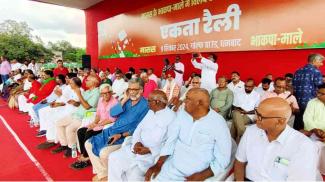The merger of the Marxist Coordination Committee into the CPI(ML) has been greatly welcomed by the broad Left ranks and well-wishers across the country. In today's situation where we have to fight state repression, corporate plunder and communal hate and violence every day on every front, unification of the Left in any degree in any part of the country will certainly be a welcome development. And when such unification happens between two leading Left forces in a crucial state like Jharkhand, it naturally generates considerable hope and potential.
The initiative for the merger came from comrades of Marxist Coordination Committee. The idea was first mooted in the wake of the 2019 and over a period of joint activities and exchanges of opinion, the two organisations developed necessary mutual confidence to accomplish it. The success of the 9 September Ekta Rally in Dhanbad has unleashed a lot of enthusiasm and determination to turn this merger into a decisive step forward towards a resurgence of the communist movement in the North Chhotanagpur division.
While the merger is primarily driven by the needs of the current situation, it also has strong roots in history. The two organisations have been products of the same period in the late 1960s and early 1970s and both grew in the common socio-political environment of undivided Bihar and now Jharkhand. The CPI(ML) emerged in April 1969 from the peasant uprising of Naxalbari following a brief coordination phase (AICCCR), suffered a setback in West Bengal and grew rapidly in neighbouring Bihar through militant anti-feudal assertion of the oppressed rural poor. The central region of undivided Bihar had emerged as the principal area of CPI(ML)'s work and influence and it spread to the Palamu and Hazaribagh-Giridih areas of today's Jharkhand. The coming together of the Liberation Front comrades led by Comrade Jayant Ganguly in Hazaribagh-Ramgarh belt and Comrade Mahendra Singh and Major Nagendra Prasad in the Giridih-Bokaro belt had lent great energy and mass strength to the CPI(ML) in the North Chhotanagpur division.
Comrade AK Roy had joined the Sindri unit of Projects and Development India Limited as an engineer in 1961 and in no time turned into a leader of workers. By 1967 he became MLA from Sindri on a CPI(M) ticket, returning again to the Assembly in 1969. But Comrade AK Roy never subscribed to the CPI(M)'s evaluation of Naxalbari as 'Left adventurism' and the consequent approach of hostility to the CPI(ML). While no votary of the early CPI(ML) call for boycott of elections, Comrade Roy underlined the need to subordinate parliamentary participation to extra-parliamentary mass assertion.
In an article titled "Vote and Revolution" published in the March 6, 1971 issue of the Kolkata-based radical weekly magazine Frontier, Comrade Roy was quite frank in his observation: "The speed and vigour with which Naxalism has spread in India and the impact it has produced speak unmistakably of its vitality, and vitality is always associated with truth". This led to Comrade Roy's expulsion from the CPI(M) and on 22 April 1972, three years after the foundation of the CPI(ML), Comrade Roy founded the Marxist Coordination Committee in Patna as an independent communist group. In the 1972 election he got elected from Sindri for the third successive time, now as an independent member of the Assembly. This was followed by three victories to Parliament from the Dhanbad Lok Sabha seat - in 1977, 1980 and 1989.
Differences with the CPI(M) continued to widen over the approach to other popular movements too. In Bihar associates of Comrade Roy took an active part in the 1974 movement and in south Bihar Comrade Roy went on to found the Jharkhand Mukti Morcha along with Shibu Soren and Binod Bihari Mahato. However, on the trade union front the Bihar Colliery Kamgar Union, the popular coal miners' union founded under the leadership of Comrade AK Roy and the Marxist Coordination Committee continued to remain affiliated to the CITU. In his political views and policy positions, Comrade AK Roy remained consistently independent. Non-sectarian in his approach, Comrade Roy had sincere respect for people's movements and strongly upheld the cause of democratic rights against every draconian law and repressive measure of the Indian state. As a leader of the working class movement he shunned economism and emphasised the social role of workers and worker-peasant unity. Under his leadership, the coal workers' struggles became an integral part of the Jharkhand movement and Bihar-origin workers also became staunch supporters of the idea of separate statehood for Jharkhand.
Over time many activists of MCC in northern and central regions of undivided Bihar had joined the Indian People's Front and CPI(ML) - prominent among them being Comrades Taqi Rahim and Rajaram. In the Dhanbad-Bokaro region too MCC and CPI(ML) worked mostly in close collaboration with Comrades Dilip Mandal and Gurudas Chatterjee working as bridges between the two organisations. In the Bihar Assembly Comrades Mahendra Singh and Gurudas Chatterjee remained comrades-in-arms and the collaboration grew in Jharkhand over the next generation. Comrade AK Roy never repudiated the idea of an organised communist party, he preferred maintaining the coordination committee form and waiting and working for the re-emergence of a united revolutionary communist party to the formation of another party. The historic MCC-ML unification has now enriched the CPI(ML) with the legacy and vision of Comrade AK Roy and other martyrs and departed leaders of the Marxist Coordination Committee.









